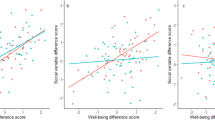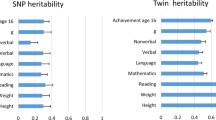Abstract
Young male twins in The Netherlands and England completed the Jenkins Activity Survey (Dutch and English versions, respectively), a measure of Type A behavior. Separate model fitting analysis revealed a similar pattern of variance estimates and associated goodness of fit across the two countries. The data were then analyzed concurrently, with a scalar parameter included to account for differences in variance due to the disparity of the measurement scales. A model including additive genetic and individual environmental effects gave a good explanation to the data. The heritability estimate was 0.28. Models of social interaction and dominance explained the data even better, the former being preferred. The twins' parents were included in the analysis to examine population variation for Type A behavior intergenerationally. There was evidence for individual environmental experiences having a greater influence on Type A behavior in the older generation.
Similar content being viewed by others
References
Appels, A. (1985).Jenkins Activity Survey, Lisse, Zeitlinger.
Bennett, P., Gallacher, J., and Johnston, D. (1990). Towards a state measure of Type A behavior.Br. J. Clin. Psychol. 29:155–165.
Bortner, R. W., Rosenman, R. H., and Friedman, M. (1970). Familial similarity in pattern A behavior.J. Chron. Dis. 23:39–43.
Carey, G. (1986). Sibling imitation and contrast effects.Behav. Genet. 16:319–341.
Carmelli, D., Rosenman, R. H., Chesney, M., Fabsitz, R., Lee, M., and Borhani, N. (1988). Genetic heritability and shared environmental influences of Type A measures in the NHLBI Twin Study.Am. J. Epidemiol. 127:1041–1052.
Carroll, D., Hewitt, J. K., Last, K. A., Turner, J. R., and Sims, J. (1985): A twin study of cardiac reactivity and its relationship to parental blood pressure.Physiol. Behav. 34:103–106.
Eaves, L. J. (1976). A model for sibling effects in man.Heredity 36:205–214.
Eaves, L. J., Last, K. A., Young, P. A., and Martin, N. G. (1978). Model-fitting approaches to the analysis of human behavior.Heredity 41:249–320.
Eaves, L. J., Eysenck, H. J., and Martin, N. G. (1989).Genes, Culture and Personality: An Empirical Approach, London, Academic Press.
Eysenck, H., and Fulker, D. (1983). The components of type A behavior and its genetic determinants.Person. Individ. Diff. 4:499–505.
Heath, A. C., Neale, M. C., Hewitt, J. K., Eaves, L. J., and Fulker, D. W. (1989). Testing structural equation models for twin data using LISREL.Behav. Genet. 19:9–35.
Jeffreys, A. J., Wilson, V., and Theil, S. L. (1985). Hypervariable “minisatellite” regions in human DNA.Nature 314:67–73.
Jenkins, C. D., Zyzanski, S. J., and Rosenman, R. H. (1971). Progress toward validation of a computer scored test for the Type A coronary prone behavior pattern.Psychosom. Med. 33:193–202.
Jenkins, C. D., Rosenman, R. H., and Zyzanski, S. J. (1974). Prediction of clinical coronary heart disease by test for coronary-prone behavior pattern.N. Engl. J. Med. 290:1271–1275.
Jenkins, C. D., Zyzanski, S. J., and Rosenman, R. H. (1978). Coronary-prone behavior: one pattern or several?Psychosom.Med. 40:25–43.
Jenkins, C. D., Zyzanski, S. J., and Rosenman, R. H. (1979).Jenkins Activity Survey Manual, The Psychological Corporation, New York.
Jöreskog, K. G., and Sörbom, D. (1988).LISREL VII A Guide to the Program and Applications, SPSS, Chicago.
Kasriel, J., and Eaves, L. J. (1976). The zygosity of twins: further evidence on the agreement between diagnosis by blood groups and written questionnaires.J. Biosoc. Sci. 8:263–266.
Koskenvuo, M., Kaprio, J., Langinvainio, H., Romo, M., and Sarna, S. (1981). Coronary-prone behavior in adult same-sexed male twins: an epidemiological study. In Gedda, L., Parisi, P., and Nance, W. E. (eds.),Twin Research 3: Epidemiological and Clinical Studies, A. R. Liss, New York, pp. 139–148.
Langeluddecke, P. M., and Tennant, C. M. (1986). Psychological correlates of the Type A behavior pattern in coronary angiography patients.Br. J. Med. Psychol. 59:141–148.
Llorente, M. (1986). Neuroticism, extraversion and the Type A behavior pattern.Person. Individ. Diff. 7:427–429.
Matthews, K. A., and Krantz, D. S. (1976). Resemblance of twins and their parents in pattern A behavior.Psychosom. Med. 28:140–144.
Matthews, K. A., and Angulo, J. (1980). Measurement of the Type A behavior pattern in children: Assessment of children's competitiveness, impatience-anger, and aggression.Child Dev. 51:466–475.
Matthews, K. A., Rosenman, R. H., Dembroski, T. M., Harris, E. L., and MacDougall, J. M. (1984). Familial resemblance in components of the Type A behavior pattern: A reanalysis of the California Type A Twin Study.Psychosom. Med. 46:512–521.
Matthews, K. A. (1988). Coronary heart disease and Type A behaviors: Update on and alternative to the Booth-Kewley and Friedman (1987) quantitative review.Psychol. Bull. 104:373–380.
May, J., and Kline, P. (1987). Extraversion, neuroticism, obsessionality and the Type A behavior pattern.Br. J. Med. Psychol. 60:253–259.
Meininger, J. C., Hayman, L. L., Coates, P. M., and Gallagher, P. (1988). Genetics or environment? Type A behavior and cardiovascular risk factors in twin children.Nurs. Res. 37:290–296.
Neale, M. C., Heath, A. C., Hewitt, J. K., Eaves, L. J., and Fulker, D. W. (1989). Fitting genetic models with LISREL: hypothesis testing.Behav. Genet. 19:37–49.
Pedersen, N. L., Lichtenstein, P., Plomin, R., DeFaire, U., McClearn, G. E., and Matthews, K. A. (1989). Genetic and environmental influences for Type A-like measures and related traits: A study of twins reared apart and twins reared together.Psychosom. Med. 51:428–440.
Rahe, R. H., Hervig, L., and Rosenman, R. H. (1978). Heritability of Type A behavior.Psychosom. Med. 40:478–486.
Rosenman, R. H., Brand, R. J., Sholtz, R. I., et al. (1976). Multivariate prediction of coronary heart disease during 8 1/2 year follow-up in the Western Collaborative Group Study.Am. J. Cardiol. 37:903–910.
Sweda, M. G., Sines, J. O., Lauer, R. M. and Clarke, W. R. (1986). Familial aggregation of Type A behavior.J. Behav. Med. 9:23–32.
Zyzanski, S. J. (1978). Coronary-prone behavior pattern and coronary heart disease: Epidemiological evidence. In Dembroski, T. M., et al. (eds.),Coronary-Prone Behaviour, New York, Springer Verlag, pp. 25–40.
Author information
Authors and Affiliations
Rights and permissions
About this article
Cite this article
Sims, J., Boomsma, D.I., Carroll, D. et al. Genetics of type a behavior in two European countries: Evidence for sibling interaction. Behav Genet 21, 513–528 (1991). https://doi.org/10.1007/BF01066728
Received:
Accepted:
Issue Date:
DOI: https://doi.org/10.1007/BF01066728




